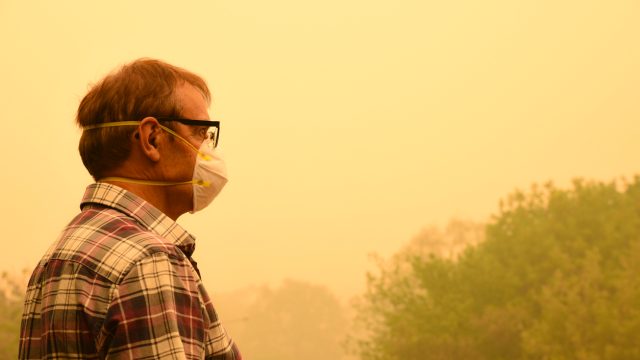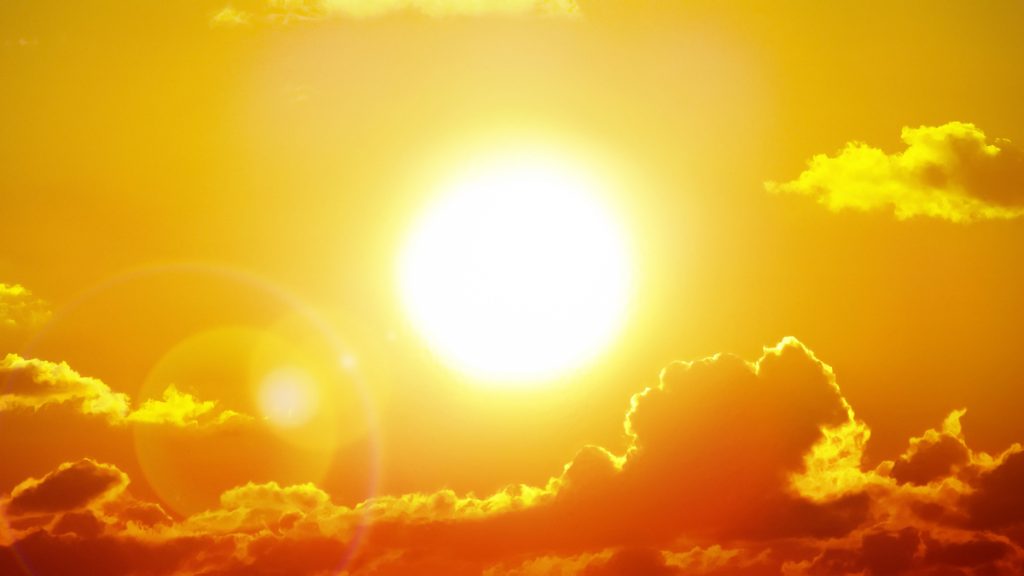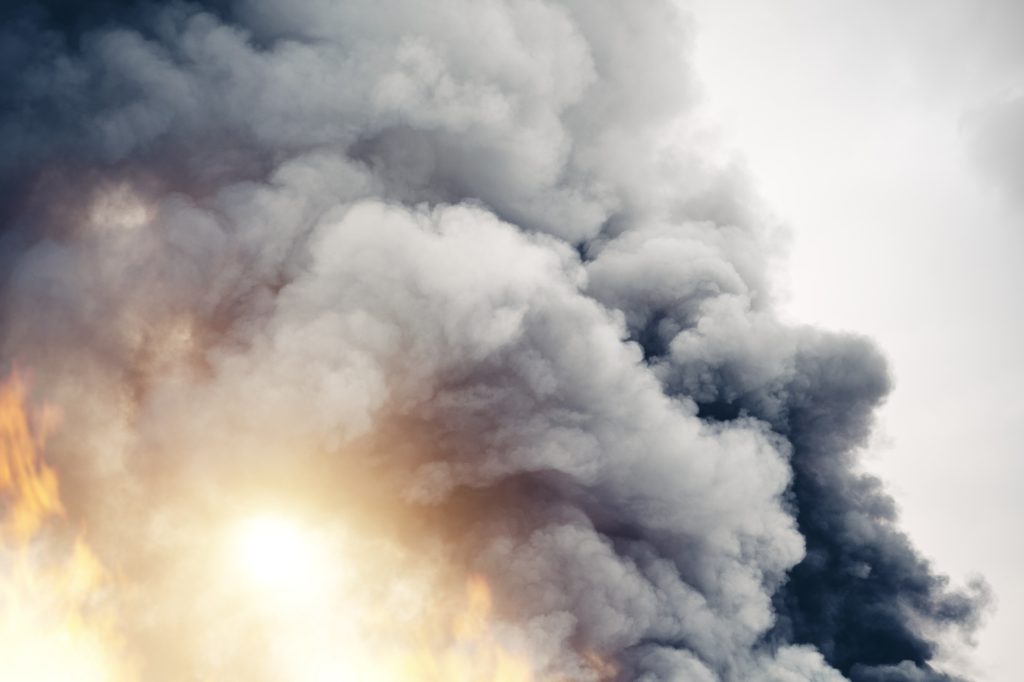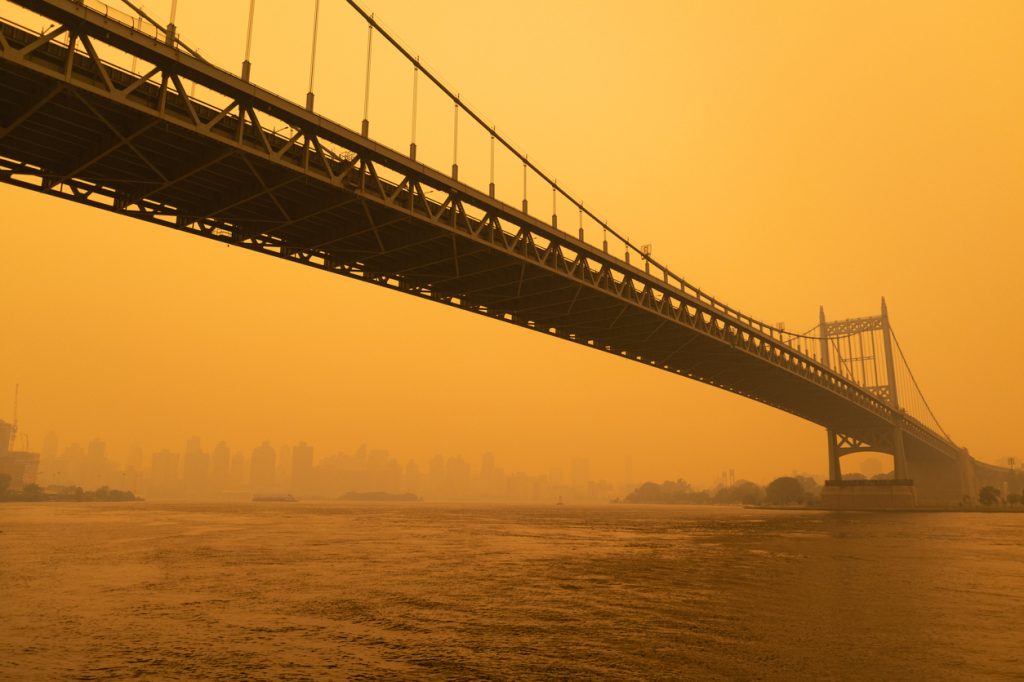“Life-Threatening” Heat and “Unhealthy” Air Have Hit the U.S.—Here’s When They’ll Clear

As the warmest season, summer is known to bring its own special type of extreme weather along with it. But this year, millions across the U.S. are already suffering under harsh conditions that can be potentially dangerous to your health. States across the South are contending with a scorching heatwave, while others in areas farther north are coping with another round of wildfire smoke that’s blanketing the region. Now, officials are warning of “life-threatening” heat and “unhealthy” air quality that could pose serious hazards to certain parts of the U.S. over the coming days. Read on for more information and to find out when they’ll eventually clear.
READ THIS NEXT: What Happens to Your Body If You Go for a Walk in Bad Air Quality.
Record-high temperatures are creating “life-threatening” conditions for tens of millions of Americans.

Summer is off to a brutally hot start for those in the southern U.S. A painfully prolonged heatwave has brought scorching hot temperatures to Arizona and Texas across to Florida, shooting above 100 degrees Fahrenheit, Reuters reports. High humidity has also pushed the heat index to dangerous heights, with Mobile, Alabama, reaching 107 degrees; Dallas, Texas, hitting 110; and New Orleans, Lousiana, soaring to 110 degrees this week.
In an advisory, the National Weather Service warned that the heat would be “life-threatening” to those spending time or working outdoors on June 28, per USA Today. It’s estimated that more than 60 million people are currently affected by some kind of heat alert.
Officials expressed concern that the current wave of record-high temperatures posed a unique safety threat besides its intensity. “There may be more danger than a typical heat event due to the longevity of elevated record high nighttime lows and elevated heat index readings during the day,” the National Weather Service warned in its advisory, per Reuters. “It is essential to have a way to cool down and interrupt your heat exposure.”
The oppressive heat could spread to more areas before it finally starts to cool down.

Unfortunately, the hot weather—which is already putting a strain on power grids in states like Texas—will likely reach more areas before conditions improve. “Going forward, that heat is going to expand … north to Kansas City and the entire state of Oklahoma, into the Mississippi Valley … to the far western Florida Panhandle and parts of western Alabama,” as Texas remains sweltering, Bob Oravec, lead forecaster with the National Weather Service, said in an update, according to local Orlando ABC affiliate WFTV.
Meteorologists say the conditions have been so long-lasting due to a weather effect known as a “heat dome,” which refers to a high-pressure system of hot air that manages to deflect cooler air fronts around it and stay in place, according to The Washington Post. Unfortunately, forecasts say the high temperatures will likely continue through at least Sunday before they improve.
Until then, officials are still warning citizens and doing their best to help combat the conditions. During a June 27 news conference, New Orleans Mayor LaToya Cantrell said her city had implemented cooling stations to keep vulnerable populations safe amid the oppressive heat.
“This is a health threat,” she told reporters. “This is unprecedented. We are living in unprecedented times. We are going to do everything necessary to meet the needs of the most vulnerable.”
Other experts pointed out that the tens of millions of people currently faced with heat warnings could do a few things to stay safe. “We can beat it by getting inside near an air conditioner, staying hydrated by drinking lots of water, and wearing moisture-wicking clothes,” Haley Brink, a meteorologist with CNN, said in an interview on June 27.
RELATED: For more up-to-date information, sign up for our daily newsletter.
Wildfire smoke is also creating dangerous conditions in other areas.

But it’s not just oppressive heat affecting large swaths of the U.S. Smoke from ongoing Canadian wildfires choked the Midwest, creating hazardous conditions in major cities throughout the region, The New York Times reports. On June 27, the air quality index (AQI) reached 209 at midday, making it the worst of any major city anywhere in the world, while Grand Rapids, Michigan, managed to hit a dangerous 255.
“This summer, cities across North America have seen unhealthy levels of air quality as a result of wildfire smoke, impacting over 20 million people from New York City; Washington, D.C.; Montreal; and today here in Chicago,” Chicago Mayor Brandon Johnson said in a statement. “As we work to respond to the immediate health concerns in our communities, this concerning episode demonstrates and underscores the harmful impact that the climate crisis is having on our residents, as well as people all over the world.”
But while Chicago experienced its first bout with wildfire smoke this week, New York and other areas in the Northeast near the Great Lakes were preparing for yet another round of harsh conditions that are likely to develop in the next 24 hours.
“The air quality is deteriorating very quickly in our state as a result of the Canadian wildfires,” New York Gov. Kathy Hochul said in a statement on June 27, per CBS News. “Right now, we’re expecting numbers all across the state to be in the unhealthy range, they’ll reach hazardous levels in much of our state. So I’m announcing, as of a few hours ago, air quality health advisories.”
Smoky conditions are expected to last for at least “the next couple of days.”

According to NWS forecasts, the latest smoke out in the U.S. is due to a low-pressure system that is pushing the polluted air southwards in a counter-clockwise direction. Environmental officials in Illinois have issued air quality alerts that remain in effect through at least midnight on June 28, while officials in Wisconsin have issued alerts through noon on June 29.
Those in New York will also be dealing with lingering smoke through Thursday. “Though forecast specifics will change, similar conditions are expected the next couple of days,” the NWS tweeted on June 27.
In response to the hazardous conditions, New York City Mayor Eric Adams urged at-risk populations to take the proper precautions. “Bring a KN95 or N95 mask with you tomorrow, or make plans to avoid outdoor events just in case,” he wrote in a tweet on June 27.